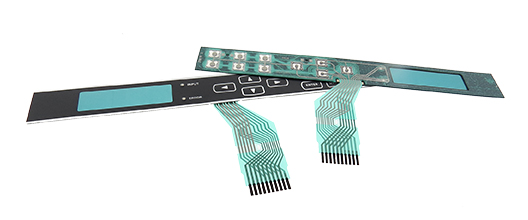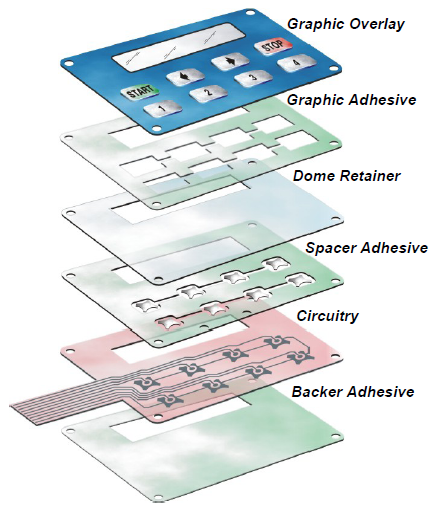12 smart ways to integrate membrane switch into industrial systems
Wiki Article
Comprehending the Importance of Membrane Layer Change in Modern Electronics
Membrane layer switches are indispensable elements in modern-day digital devices. They offer a mix of functionality and layout that boosts customer communication. Their light-weight and long lasting nature makes them ideal for numerous applications. As markets evolve, the need for customization and advanced features expands. Recognizing just how membrane layer switches over add to innovation reveals their value fit the future of electronic devices. What lies ahead for this technology?The Basics of Membrane Layer Switch Modern Technology
Frequently forgotten, membrane button technology plays an essential duty in the modern electronic devices landscape. These devices, made up of multiple layers, act as interface for different electronic products, varying from household devices to clinical equipment. A normal membrane layer switch is composed of a visuals overlay, a spacer layer, and a circuit layer, which are carefully constructed to create a practical interface.When stress is put on the overlay, the circuit layer is completed, enabling signals to be sent to the device. This innovation is recognized for its adaptability, enabling modification in shape, layout, and performance to meet particular individual demands. In addition, membrane switches are thin and lightweight, making them appropriate for applications where area is a premium. Their longevity and resistance to environmental elements even more improve their charm, ensuring they can endure extreme problems while preserving performance. Generally, membrane switch technology is essential to creating user-friendly and efficient digital tools
Secret Advantages of Membrane Layer Changes
Membrane switches over offer several vital advantages that make them a preferred option in numerous electronic applications. Their layout permits a small form variable, allowing producers to develop light-weight and sleek tools. Additionally, membrane layer switches are immune to dust, dampness, and chemicals, which improves their resilience and longevity sought after environments. The responsive feedback supplied by these switches can improve user experience, making them very easy and user-friendly to operate.Furthermore, membrane layer switches can be tailored with diverse graphics and colors, enabling distinct branding possibilities. The manufacturing procedure is generally economical, specifically for high-volume production, as it minimizes setting up time and simplifies design. Ultimately, membrane layer switches need marginal upkeep, adding to lower total operational prices. These advantages highlight their expanding popularity in modern electronics, where reliability and user-friendly interfaces are essential.
Applications Across Various Industries
The convenience of membrane switches over allows their widespread adoption across numerous industries. In the clinical area, they are frequently used in diagnostic devices and client monitoring systems, offering a long lasting interface resistant to pollutants. The automobile industry uses membrane layer buttons for dashboard controls, improving individual experience with smooth styles that endure extreme conditions. In consumer electronic devices, they offer as control board for tools such as microwaves and coffee machine, providing a straightforward user interface that is easy to clean. The aerospace sector employs membrane buttons in cabin controls, where integrity and area effectiveness are vital. Furthermore, the industrial industry leverages these switches in machinery and control systems to ensure robust operation popular environments. This broad variety of applications highlights the flexibility of membrane layer switches, making them important components in enhancing functionality and individual communication throughout varied technical landscapes.Customization and Design Versatility

Future Fads in Membrane Layer Change Advancement
Emerging trends in membrane layer button advancement suggest a growing emphasis on boosted capability and combination with wise innovations. As consumer need for a lot more advanced electronic devices rises, suppliers are concentrating on producing membrane switches that not just serve basic functional duties however likewise integrate functions like touch sensitivity, backlighting, and haptic feedback.Furthermore, advancements in products are anticipated to improve durability and environmental resistance, making membrane layer changes suitable for varied applications in markets such as healthcare, automotive, and customer he has a good point electronics. The assimilation of capacitive touch innovation is likely to come to be much more prevalent, enabling sleeker designs and boosted individual interfaces. membrane switch.Additionally, the surge of the Web of Things (IoT) is motivating the development of membrane layer changes that can connect wirelessly with other tools, enhancing interconnectivity. On the whole, the future of membrane button technology shows up promising, driven by technology and the pursuit of straightforward servicesRegularly Asked Questions
Exactly How Do Membrane Layer Switches Contrast to Typical Mechanical Switches?
Membrane layer buttons, being much more space-efficient and supplying a smooth layout, contrast with conventional mechanical buttons that provide tactile responses. The former typically include customizable graphics, while the last commonly guarantee longevity and reliability in different applications.What Products Are Generally Utilized in Membrane Switch Over Production?
Membrane buttons are typically created utilizing products such as polyester, polycarbonate, and published conductive inks. These products give longevity, responsiveness, and adaptability, making them suitable for various applications in electronic devices and interface.Can Membrane Switches Be Fixed or Recycled?
Membrane layer buttons can commonly be repaired, particularly if small problems occur, such as adhesive failing or surface damage. Nonetheless, total reuse is usually limited as a result of use and prospective degradation of products in time.
Exactly How Do Ecological Aspects Affect Membrane Layer Change Efficiency?
Environmental factors, such as temperature, direct exposure, and humidity to chemicals, considerably influence membrane button performance. Severe problems can result in destruction, affecting responsiveness and long life, ultimately jeopardizing the capability of the gadget in numerous applications.What Is the Typical Life Expectancy of a Membrane Layer Switch?
The normal life-span of a membrane switch generally varies from 1 to 5 million actuations, depending on aspects such as use frequency, environmental problems, and the products used in manufacturing, affecting resilience and efficiency long life. A typical membrane switch consists of a visuals overlay, a spacer layer, and a circuit layer, which are diligently assembled to create a practical interface - membrane switch.When stress is used to the overlay, the circuit layer is finished, allowing signals to be transferred to the gadget. The responsive responses given by these switches can enhance user experience, making them simple and user-friendly to operate.Furthermore, membrane layer buttons can be tailored with varied graphics and shades, enabling for special branding possibilities. As customer need for a lot more innovative digital gadgets boosts, makers are concentrating on producing membrane layer changes that not only offer standard operational roles yet likewise incorporate attributes like touch level of sensitivity, backlighting, and haptic feedback.Furthermore, improvements in products are anticipated Homepage to enhance longevity and ecological resistance, making membrane layer changes suitable for diverse applications in sectors such as medical care, vehicle, and customer electronics. The integration this article of capacitive touch technology is most likely to end up being more prevalent, permitting for sleeker styles and enhanced user interfaces.Additionally, the surge of the Web of Things (IoT) is prompting the growth of membrane switches that can connect wirelessly with other devices, improving interconnectivity. Membrane buttons, being a lot more space-efficient and providing a sleek style, contrast with typical mechanical switches that provide responsive feedbackReport this wiki page